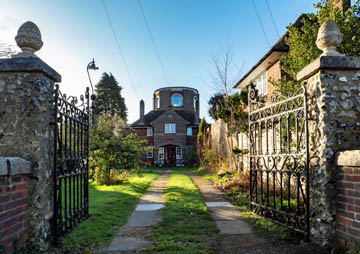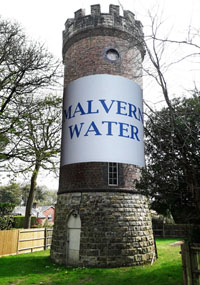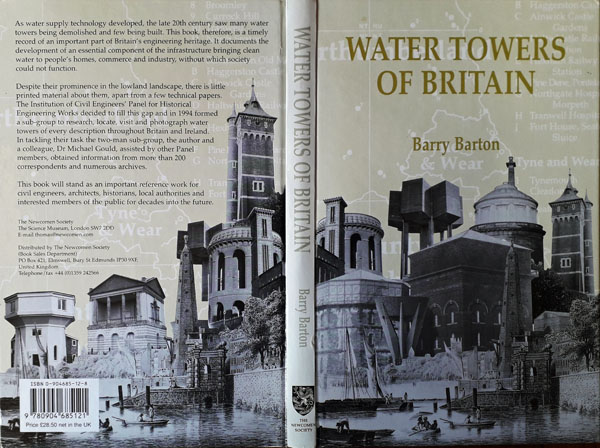|


Home Page - WONDERFUL WATER TOWERS IN GREAT BRITAIN - This web site does not contain commercial advertising, should any advertisements appear you are advised to ignore them.
This is one of a number of tourism databases created at:
Tower House, Tower Road
Tadworth
KT20 5QY
Surrey
United Kingdom
Telephone: 01737 213169
Water Towers have been key elements in the developed landscapes of communities. They provide a gravity powered water supply to localities both residential and industrial. Local water companies built them on their highest points and pumped water up from sources at lower levels. The water was then distributed by piped infrastructure to those the company served.
The golden age of water towers is seen as the twentieth century. Today many towers have become redundant due to their locations not being sufficiently high enough to service the consumers, as the demand for water expands. Also modern pumping has enabled water pressure to be maintained without such towers.
As a result these once iconic structures, that epitomised the important role of the water company to the community, have been destroyed or converted to other uses. Their architecture proudly reflected their role and this has led to a challenge to find alternative uses for such towers. On this database we record a few examples that have survived in Great Britain. The information that we give on each tower is to the best of our knowledge, but should be verified if used for formal purposes.
In the database each tower has a unique identity code shown in brackets. The first number indicates the map on which Barton lists the tower, the letter(s) identify the county(s) and the last number or letter identifies the tower's position on Barton's list. Source: Barton B. (2003) Water Towers of Britain. Newcomen Soc.
We are seeking help from someone in northern England to explore and record the towers there for our web site. Drop us an email to the address below if interested.
Website: Click Here
ADDITIONAL INFORMATION
Click website above to view the Research Fellowship pages. Email the address below to contact the authors.
Click the county logos to explore by county clicking the small pictures to see larger illustrations.
This site is still under construction. Whilst every effort is made to ensure information is correct, should you spot an error do let us know.
For email contact - bruce.e.osborne@gmail.com
Areas covered by county web pages - click the logos below to view the county listings now available.
1 Devon (DV) and Cornwall (CW)

2 Somerset (SS) and Dorset (DO)

3 Avon (AV) and Wiltshire (WT)

4 Hampshire (including Isle of Wight) (HS)

5 Greater London (GL), Surrey (SY) and West Sussex (WS)

6 Kent (KT) and East Sussex (ES)

7 Oxfordshire (OX) and Berkshire (BK)

8 Buckinghamshire (BU) and Bedfordshire (BE)

9 Hertfordshire (HT)

10 Essex (EX)

11 Cambridgeshire (CB)

12 Suffolk (SF)

13 Norfolk (NF)

14 Hereford & Worcester (HW) and Gloucestershire (GL)

15 Warwickshire (WS) and Northamptonshire (NS)

16 Shropshire (SH), Staffordshire (ST) and West Midlands (WM)

17 Derbyshire, Nottinghamshire and Leicestershire (LE)

18 Lincolnshire (LS)

19 Greater Manchester, Merseyside and Cheshire (CH)

20 Humberside(HS) and South Yorkshire

21 North Yorkshire (NY) and West Yorkshire (WY)

22 Cumbria and Lancashire

23 Northumberland, Tyne & Wear, Co Durham and Cleveland

24 Wales including South Wales (WA)

25 Scotland (with Glasgow Area as inset)

Towers not yet included in county lists are below

WATER TOWER near Hull Prison, (00HS00)
Little is known about this tower. It can be viewed from the main road opposite the main entrance to Hull Prison and may be associated with this institution. We would welcome further information.
 Now discover MALVERN Water in MALVERN Water Towers worldwide by clicking below.
Now discover MALVERN Water in MALVERN Water Towers worldwide by clicking below.


The above book, published in 2003, is a valuable source of information on water towers and has been a historic guide in research for this web site. Click the image to find out more about water towers.
See above:- If you have details of a Water Tower that is not yet added to our web site please let us know, especially if you have a picture that we could use. Contact: bruce.e.osborne@gmail.com
The Golden Age of the Water Tower = the 20th century = a defined era in the history of the world as civilisation progressed.
The Golden Age of the Water Tower, also known as the elevated tank, was the twentieth century. New technologies had evolved in Victorian times (1837/1901) that transformed the way people lived. The supply and distribution of clean water not only changed our day-to-day existence, it also extended our lives, as pollution of water was brought under control. It enabled domestic households, businesses and institutions to receive a direct supply of clean water.
New local water companies developed the facilities for collecting and purifying local natural water sources. They also developed piped distribution networks to enable houses and businesses to have on-site supplies via a piped network. Such a network needed a pressure to circulate the water throughout the pipes and this is where water towers played their role. Having filled the water tower tank, gravity at this high point in the network forced the water through the distribution pipework to its ultimate user.
The water tower was a visible symbol of the success of the new technology and this was reflected often in the style and elaborate design of the iconic tower. Local areas erected towers at the highest point of their pipe network. These landmarks added a new feature to the landscape and sent a message to all that the new technology was here to stay for all to benefit from as the vast network of pipes and associated facilities evolved. The elaborate designs emphasised the importance, respect and celebration of the water supply.
In 1898, the Sutton Water Company south of London built a brick tower with metal tank on top at Tadworth on the North Downs. The company pumped the purified spring water from the local chalk aquifer and springs in Sutton up to the tower. From there it was distributed to all and sundry as demand was met with the installation of the pipe network. As the twentieth century progressed, availability of such water was taken for granted. In 1956 the British Waterworks Association recorded 1058 water undertakings. By 1965 this number had dropped to 422 as organisations merged and extended their overall networks and areas of control and management. As a result, the Tadworth tower was eventually replaced by another evenly more elaborately designed tower higher on the North Downs and the Tadworth tower is now a domestic habitation, illustrating a popular reuse of these buildings.
By the 21st century, advanced electronic pumping steadily took over from the water tower for the creation of pressure in the water distribution pipework. Gradually water towers started becoming redundant and whilst new uses evolved for some, others were quietly demolished to make was for modern housing and other 'grey land' use. As a result, today there are still many water towers in use acting as iconic memorials to the evolution of water distribution technology. Others have been converted to residential and other uses. Their location on high ground and the often interesting and amazing design promotes their magnificence.
We can now look back in awe at the presence of these widely varied design of these towers in our landscape. Water storage had existed for centuries but the tower is a distinct reflection of the Golden Age of the Water Tower.
Types of towers that were created included institutional, public utility, industrial, private estates, railways and military.
Materials such as brick, local stone, metal and as time progressed concrete all added variety to the designs, some were circular and others square and some weird combinations of shape. Some were decorated in traditional architectural styles and others stunningly created in modernistic styles, particularly as concrete became a very versatile building material. Some have the tank supported on one or more legs and others supported the tank on a solid-state building. With some the tank was exposed as a feature at the top, with others it is concealed inside. Many had a plaque recording by who and when created as they proudly promoted their cause.
The result has been a building that could capture the imagination of those who viewed it as a landscape feature and, when the towers fell out of use, could lead to the evolution of imaginative new uses for these amazing monuments to revolutionising people's lives, usually located at the very summit of a hill for all to see.
For email contact - bruce.e.osborne@gmail.com
REGION
Not Regional, WATER TOWER INTEREST
|






































 Now discover MALVERN Water in MALVERN Water Towers worldwide by clicking below.
Now discover MALVERN Water in MALVERN Water Towers worldwide by clicking below.

